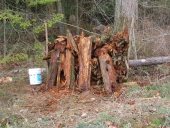The beds should be as steep as possible: less compaction, it's also easy to reach the top of the bed without stepping on the bottom...
70 degres is maybe about the ideal, or ''when the soil is almost falling!''
The top of the bed should not be too flat because water can accumulate and compact the bed.
It's possible to walk on top of the bed where a 1-2 foot path is naturally created I guess just by walking, Don't walk on the sides as you will just push down the soil.
Maybe we can just create a path at the beginning of the beds and at the end to get on top, we can more easily broadcast seed all over the bed and also harvest the fruits (if there is trees planted on top.)
There is no problem in using alive trees, taking out of the forest 1 part on 40 is what we should do to keep an healthy forest.
Not tu put manure/compost with the wood in the trench but on top of the bed, maybe under a mulch.
It's possible to build a big bed at the edge of the garden as a windbreak (and plant something big on top), so we can consider others factors like the shape of the field, or just a special design (circle, spiral...) for the hugelbeds.
The beds are ideally as highs as the farmer.
How long they last depends of what materials they are made of:
Big materials provide a regular source of nutrients and heat for a longer period, 10 years or more depending of what wood, what size the beds are etc....
Small materials should be only one forth of the soil of the bed, otherwise it might just give too much nutrients too fast. It's a good thing to use heavy feeders during the first years on those kind of bed.
It's a good idea to think with what equipment we want to eventually remake the beds so we can make the pathways wide enough for that purpose.
Trees/shrubs can be planted in the middle of the pathways. To get more sun we lower the density of the planting, and increase this density in the opposite case, planting the fruit trees on top of the beds would help to make even more shade.
I think it's good to plant shrubs only on the pathway, not on the beds. (except if the beds are 1 or 2 meters high only) A good idea could also be to plant shrubs at the beginning\end of every beds.
Pigs/duck/chickens might be the good animals to let in the beds during a limited time depending of the size of the garden/number of animals.
Pigs can be directed with food, maybe letting them once or twice a year. Broadcast seeding after the pig worked the soil is the best.
Another idea is to let enough room between every bed to sit a manure pile, (and ideally adding biodynamic preps) then spread the
compost over the sides.
By growing the most diverse things all together and by creating an almost permanent no till\no irrigation beds we give nature the best chance to improve the quality and the structure of the soil, but adding some compost once in a while can't do any harm.
The sod can be put upside down on top of the wood. The humus should be collected and spreaded over the top so at list the last layer of soil is kept at its supposed place.
The trench digegd up can be as deep as possible (1-1.5m). The width of the beds is about 2-3m wide for a bed higher than 6 feet. While piling the logs keep in mind the goal is to make the sides as steep as possible and no flat top, this is what will greatly influence their definitive form.
It's good to have a rough soil before broadcast seeding as the seeds will fall in the holes and be protected from the drought while sprouting.
There must be no stones on the sides of the beds because they might pull down this soil that we want to keep step. But on the pathways or also some huge ones at the edges of every beds would look nice and provide habitat for worms, accumulate heat.
It's a good idea to broadcast seed right after the beds are created to prevent erosion.











